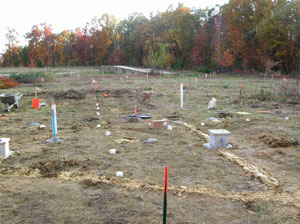USGS uses porous pots in bioremediation work
The United States Geological Survey used thirty porous pots as part of a multifaceted study on techniques for optimizing bioremediation work in 2016.
Bioremediation refers to the practice of adding microorganisms and/or nutrients for existing microbes to contaminated soil to accelerate natural decomposition processes. Liquid nutrients for microbes are typically injected blindly into the soil without a good in-situ understanding of how the nutrients (so-called “amendments”) disperse once injected into the soil.
Since liquid amendments change soil conductivity, the USGS investigated how electro-geophysical methods like the self-potential (SP) and induced-polarization (IP) methods with porous pots can be used to monitor soil conductivity over a bioremediation area during amendment injections.
View the USGS photo gallery for the experiment here: https://water.usgs.gov/ogw/bgas/estcp/bioremed-monitor-gallery.html
Read the full USGS report here: https://clu-in.org/download/contaminantfocus/dnapl/Treatment_Technologies/Bio-performance-ER-200717-FR.pdf


